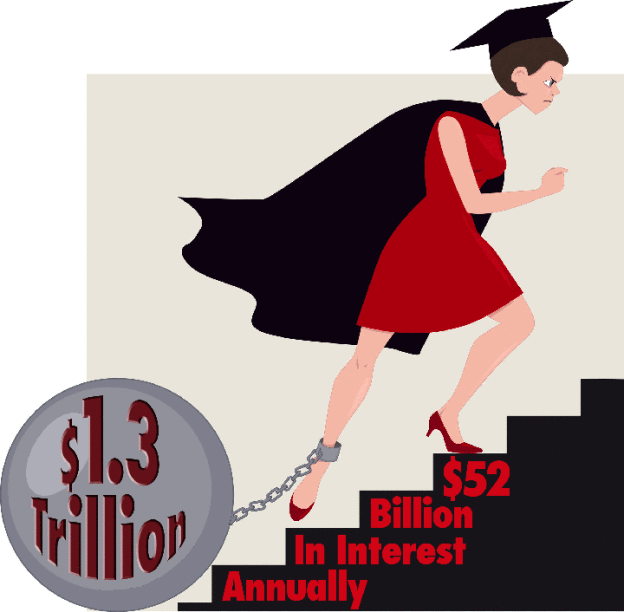TABLE OF CONTENTS
What is the cause of the student loan debt problem and is there a solution?
The total amount of outstanding student loan debt is a number often thrown around—a staggering 1.6 trillion dollars. It’s just 2 digits and a decimal point, but in reality, it’s a much larger number with huge ramifications and it’s making us see red!
Can you imagine having to write a check for:
1 Trillion 6 Hundred Billion Dollars
Or $1,600,000,000,000.00
RELATED VIDEO: Be sure to watch the video at the bottom of this page where we interview Jocelyn – a college graduate who earned more than $100,000 in scholarships. She graduated Debt-Free from a prestigious business school.




Breaking Student Loan Debt down:
There are 43 million students who currently owe money for student loans.
Divide 1.6 billion by 43 million and you get an average of $37,209 per student. Of course some borrowed much less – like a friend of ours, Anna. She borrowed a couple of thousand dollars her first year of college, then decided to do things differently. She worked hard all summer, paid off the debt and then applied for a job as an RA.
Bingo, free room and board. Because of good grades her tuition was covered. She just graduated – debt free . . . with a positive net worth — in the black!
Unfortunately (or fortunately for her), she can’t be counted in the 1.6 trillion dollars of debt. And she can’t even be counted in the average, but there are some students who worked hard and worked smart to pay for school, and in the end graduated with a couple of thousand dollars in debt.
Good for them.
Bad for the average.
For everyone who graduates with $2000 debt that means that someone else (who wants to keep the statistics correct) would have chosen to borrow $63,000. We know. It’s not really that way. But when you look at statistics sometimes you just think irrational thoughts.
Okay enough with the average amount owed. Let’s get to the point of this blog.
Student Loan Interest
The cost of borrowed money. The little charge that has huge ramifications if you continue to pay it year after year after year. We haven’t heard anyone mention how much interest is being paid each year on that 1.6 trillion dollars in debt. And honestly, there’s just no way to know exactly what that amount is, but we can do some calculations.
Let’s be generous and estimate an average of 4 percent interest.
We know some are paying much more and some may be paying a little less. But for arguments sake let’s just go with 4 percent.
$1,600,000,000,000.00 x .04= $64,000,000,000
Check my math—is it correct? Because if it is, I came up with $64 BILLION in interest being paid each and every year.
By the way, if you divide the $64 billion by 43 million borrowers, it’s an average of $1488 in interest each year (remember that doesn’t include paying back the principal). But $64 billion dollars is a huge amount and it’s the cost of being in debt (in the red!)
$64 Billion dollars that can’t be used for buying homes, cars, having babies, building businesses, or going to McDonalds
That $64 Billion isn’t used to stimulate our economy, that is unless of course, you are a company (or work for one) that loans money for higher education.
Then the $64 Billion created your job, your income and the company’s ability to rent office space and pay its executives multimillion-dollar salaries, so they can buy bright red sports cars and large homes.
But to put $64 Billion dollars into a global perspective consider this:
The amount of interest paid on U.S. student debt is a little less than the Gross Domestic Product of Guatemala and a little more than the GDP of Costa Rica.
Let’s take it a little further.
According the United Nations: Of the 194 countries in the world, only 78 of them have a GDP greater than 64 billion dollars.
The amount of interest paid on student loans each year ranks in the top 40 percent of world economies.
It’s Time to Stop the Obscene Borrowing Game.
We are mortgaging our future and the futures of our children. It’s time to stop the madness and start GETTING MAD (and smarter) about the high cost of education.
It’s time for someone to start blazing a trail to quality educations that won’t enslave our children (or you) to Sallie Mae for the next decade or two.
It’s time for our smart kids and their smart parents to say no to outrageous tuition and yes to smarter schools who are holding down costs.
- Look at Grand Canyon University and several others who have frozen tuition for the past 5 years or more.
- Look at innovator schools like Southern New Hampshire University that offer two different online bachelor’s degrees for a guaranteed total cost of $10,000 including books and fees.
- Check out the 21 states that have approved community colleges to offer four year degrees. This may not sound like a revolutionary idea, but when you consider that the tuition charged by community colleges is usually 50 to 70 percent less than local universities, it is a great option for students wanting to graduate with a degree and a positive net worth.
As consumers, our voice matters. As students, where we enroll matters.
Every time we send a student to an overpriced university, using expensive borrowed money, we’ve just validated the amount the school charges for tuition. If their enrollment dropped, so would their prices.
There you have it.
64 billion reasons to stop stimulating the economy of the lenders who are profiting from our desire to get a better education, and buying flashy red sports cars.
64 billion reasons to keep that money in your bank account so you can graduate with a positive net worth and then buy that house, have that baby, build that business, or buy your own black Corvette or Mini Van (paid for with cash of course).
Red or Black? Are you living in the red or in the black?
Download our audio file: Debt Free College: Fantasy or Reality to learn how we helped our kids, and thousands of others, graduate without debt and WITH a positive net worth. (it’s only $10 but could save you $100,000).
How to Avoid Student Debt with Scholarships
Learn more about Jocelyn and her Scholarship System. She offers a free introductory webinar every few days. You can get on the Scholarship System waiting list here. Besides lots of great scholarship information, she’ll also share about the Scholarship System course and offer you a substantial discount ($200+) at the end of the webinar.

